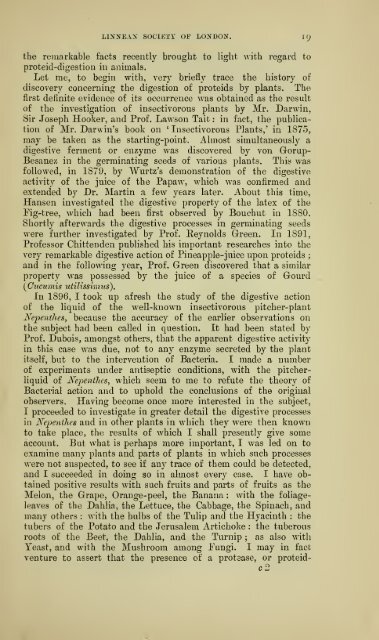Proceedings of the Linnean Society of London - University Library
Proceedings of the Linnean Society of London - University Library
Proceedings of the Linnean Society of London - University Library
Create successful ePaper yourself
Turn your PDF publications into a flip-book with our unique Google optimized e-Paper software.
LINNEAX SOCIETY OF LONDON. 1<br />
<strong>the</strong> remarkable facts recently brought to light with regard to<br />
proteid-digestion in animals.<br />
Let me, to begin with, very briefly trace <strong>the</strong> history <strong>of</strong><br />
discovery concerning <strong>the</strong> digestion <strong>of</strong> proteids by plants. The<br />
first definite evidence <strong>of</strong> its occurrence was obtained as <strong>the</strong> i*esult<br />
<strong>of</strong> <strong>the</strong> investigation <strong>of</strong> insectivorous plants by Mr. Darwin,<br />
Sir Joseph Hooker, and Pr<strong>of</strong>. Lawson Tait : in fact, <strong>the</strong> publication<br />
<strong>of</strong> Mr. Darwin's book on ' Insectivorous Plants," in 1875,<br />
may be taken as <strong>the</strong> starting-point. Almost simultaneously a<br />
digestive ferment or enzyme was discovered by von Gorup-<br />
Besanez in <strong>the</strong> germinating seeds <strong>of</strong> various plants. This was<br />
followed, in 1879, by AVurtz's demonstration <strong>of</strong> <strong>the</strong> digestive<br />
activity <strong>of</strong> <strong>the</strong> juice <strong>of</strong> <strong>the</strong> Papaw, which was confirmed and<br />
extended by Dr. Martin a few years later. About this time,<br />
Hansen investigated <strong>the</strong> digestive property <strong>of</strong> <strong>the</strong> latex <strong>of</strong> <strong>the</strong><br />
Fig-tree, which had been first observed by Bouchut in 1880.<br />
Shortly afterwards <strong>the</strong> digestive processes in germinating seeds<br />
were fur<strong>the</strong>r investigated by Pr<strong>of</strong>. Eeynolds Green. In 1891,<br />
Pr<strong>of</strong>essor Chittenden published his important researches into <strong>the</strong><br />
very remarkable digestive action <strong>of</strong> Pineapple-juice upon proteids ;<br />
and in <strong>the</strong> following year, Pr<strong>of</strong>. Green discovered that a similar<br />
property was possessed by <strong>the</strong> juice <strong>of</strong> a species <strong>of</strong> Gourd<br />
{Cucumis utiltssimits).<br />
In 1896, I took up afresh <strong>the</strong> study <strong>of</strong> <strong>the</strong> digestive action<br />
<strong>of</strong> <strong>the</strong> liquid <strong>of</strong> <strong>the</strong> well-known insectivorous pitcher-plant<br />
Nepen<strong>the</strong>s, because <strong>the</strong> accuracy <strong>of</strong> <strong>the</strong> earlier observations on<br />
<strong>the</strong> subject bad been called in question. It had been stated by<br />
Pr<strong>of</strong>. Dubois, amongst o<strong>the</strong>rs, that <strong>the</strong> apparent digestive activity<br />
in this case was due, not to any enzyme secreted by <strong>the</strong> plant<br />
itself, but to <strong>the</strong> intervention <strong>of</strong> Bacteria. I made a number<br />
<strong>of</strong> experiments under antiseptic conditions, with <strong>the</strong> pitcher-<br />
liquid <strong>of</strong> Nepen<strong>the</strong>s, which seem to me to refute <strong>the</strong> <strong>the</strong>ory <strong>of</strong><br />
Bacterial action and to uphold <strong>the</strong> conclusions <strong>of</strong> <strong>the</strong> original<br />
observers. Having become once more interested in <strong>the</strong> subject,<br />
I proceeded to investigate in greater detail <strong>the</strong> digestive processes<br />
in Nepen<strong>the</strong>s and in o<strong>the</strong>r plants in which <strong>the</strong>y were <strong>the</strong>n known<br />
to take place, <strong>the</strong> results <strong>of</strong> which I shall presently give some<br />
account. But what is perhaps more important, I was led on to<br />
examine many plants and parts <strong>of</strong> plants in which such processes<br />
were not suspected, to see if any trace <strong>of</strong> <strong>the</strong>m could be detected,<br />
and I succeeded in doing so in almost every case. I have obtained<br />
positive results with such fruits and parts <strong>of</strong> fruits as <strong>the</strong><br />
Melon, <strong>the</strong> Grape, Orange-peel, <strong>the</strong> Banana : with <strong>the</strong> foliageleaves<br />
<strong>of</strong> <strong>the</strong> Dahlia, <strong>the</strong> Lettuce, <strong>the</strong> Cabbage, <strong>the</strong> Spinach, and<br />
many o<strong>the</strong>rs : with <strong>the</strong> bulbs <strong>of</strong> <strong>the</strong> Tulip and <strong>the</strong> Hyacinth : <strong>the</strong><br />
tubers <strong>of</strong> <strong>the</strong> Potato and <strong>the</strong> Jerusalem Artichoke : <strong>the</strong> tuberous<br />
roots <strong>of</strong> <strong>the</strong> Beet, <strong>the</strong> Dahlia, and <strong>the</strong> Turnip ; as also with<br />
Yeast, and with <strong>the</strong> Mushroom among Fungi. I may in fact<br />
venture to assert that <strong>the</strong> presence <strong>of</strong> a protease, or<br />
c2proteid-<br />
9










![Novellen [microform] - University Library](https://img.yumpu.com/21939450/1/171x260/novellen-microform-university-library.jpg?quality=85)
![Anecdota Chisiana de re metrica [microform]](https://img.yumpu.com/21939448/1/190x239/anecdota-chisiana-de-re-metrica-microform.jpg?quality=85)



![Schollenbruch [microform] : Gedichte - University Library](https://img.yumpu.com/21939437/1/174x260/schollenbruch-microform-gedichte-university-library.jpg?quality=85)

